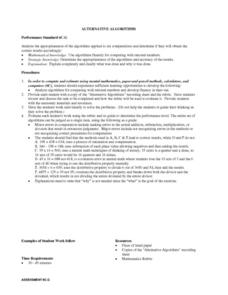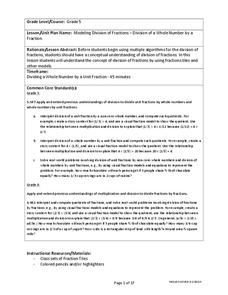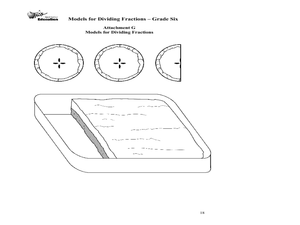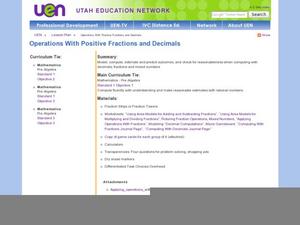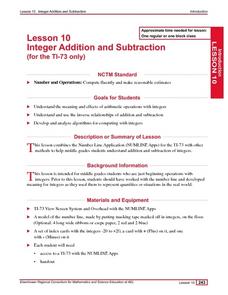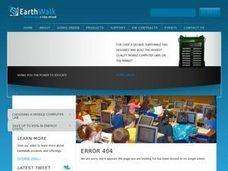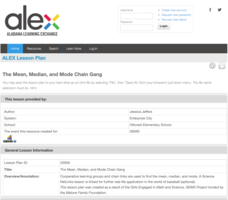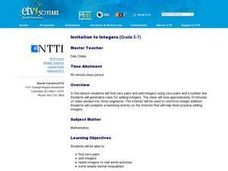For the Teachers
$1 Math
Captivate your class by having them find the value of their names, different zoo animals, musical instruments, etc.,with a mental math lesson. Using the coding formula listed, children learn to fluently estimate and calculate...
Curated OER
Alternative Algorithms
Analyze algorithms for computing with rational numbers and develop fluency in their use with your math class. They work individually to solve the problems on the "Alternative Algorithms" sheet. Then, they analyze the appropriateness of...
Virginia Department of Education
Integers: Addition and Subtraction
Young mathematicians construct their own understanding of integers with an inquiry-based math lesson. Using colored chips to represent positive and negative numbers, children model a series of addition and subtraction problems as...
West Contra Costa Unified School District
Modeling Division of Fractions
Introduce young mathematicians to the process of dividing fractions with a hands-on math lesson. Using the help of fraction strips and other visual models, children work through a series of example problems as they...
Curated OER
Models and Algorithms to Solve Multiplication Problems
Students choose the correct strategy to solve multiplication and division. In this algorithm lesson, students use at least two strategies that use properties of operations and estimation. Students also recognize the relationship between...
NTTI
Putting Together Ten
Groups explore sets of 10 items in two varieties (i.e. 3 white buttons and 7 black ones, or 5 bears and 5 bunnies). They brainstorm about their objects, write math sentences to represent what they have, and report their discoveries...
Curated OER
Pizza Fractions
Everyone loves pizza! Learners define fractions and use manipulatives to calculate fractions. Kids cut circles to represent various fractional parts of a pizza. Some accommodations are included.
Curated OER
Divisor The Great! (Divide by Two-Digit Divisors)
Manipulatives make learning division easier! Your class will discover the difference between dividing with one- and two-digit divisors, and practice the procedures for each using the standard algorithm. They will use estimation to ensure...
Curated OER
Add It Up In Number Ville! Adding 2-Digit Numbers With and Without Regrouping
Students explore adding 2-digit numbers. In this math instructional activity, students identify 2-digit numbers and use base ten blocks to practice adding. Students use addition to break a code.
Ohio Department of Education
Models for Dividing Fractions - Grade Six
Fifth and sixth graders use food and candy to help them represent division of fractions and develop algorithms to solve fraction problems. They discuss dividing whole numbers by fractions. Pupils use sticks and chocolate bars to...
Curated OER
Dream Car Math
Pupils collect car cost comparison data from the "Car Wizard" web site to use as problem solving and for calculations related to math.
Curated OER
Adding and Subtracting Decimals
Fourth graders develop the concept of adding and subtracting decimals. In this decimal lesson, they participate in a teacher directed demonstration of how to add and subtract decimals. They work in teams as each person performs one step...
Curated OER
Junk Yard Math
Third graders explore the process of place value and subtraction through regrouping and borrowing exercises. Several activities using manipulatives are utilized in the lesson.
Curated OER
I.O.U.
Students explore adding and subtracting positive and negative numbers in the context of money. In this computation lesson, students use play money and IOU's to model various mathematical algorithms.
Curated OER
Operations with Positive Fractions and Decimals
Explore the concept of fractions and decimals! In this fractions and decimals lesson, pupils use fraction tiles to express fractions. They play a fraction review basketball game where when a team gets a question correct they get to shoot...
Arizona Department of Education
Area and Perimeter of Regular and Irregular Polygons
Extend young mathematicians' understanding of area with a geometry lesson on trapezoids. Building on their prior knowledge of rectangles and triangles, students learn how to calculate the area of trapezoids and other...
Eisenhower Regioanl Consortium for Mathematics and Science Education
Lesson 10: Integer Addition and Subtraction (for the TI-73 only)
Using a number line on the floor made from masking tape and manipulatives, learners observe a demonstration of the addition and subtraction processes. After completing several worksheets, they solve three-term problems using calculators...
Curated OER
Students' Strides
Complete problems using base ten blocks to see the difference in the place value of a decimal and how it affects a number's value. Learners compare decimal values as well. Ample time for discussion and modeling are allowed in the...
Curated OER
Interactive Fractions
Middle schoolers determine the common denominator of two unlike fractions. They practice adding fractions and finding equivalent fractions of numbers. They compare and contrast different types of equations involving fractions and...
Curated OER
1st Grade Problem Solvers
First graders investigate, represent and solve problems using number facts, operations, and their properties. They solve on-step addition and subtraction number sentences and word problems using concrete materials. Students construct...
Alabama Learning Exchange
The Mean, Median, and Mode Chain Gang
Students analyze a set of data. They work in cooperative groups and use chain links to identify the mean, median, and mode of the chain.
Curated OER
Invitation To Integers
Students find zero pairs and add integers using zero pairs and a number line. They generalize rules for adding integers. The class view approximately 10 minutes of video divided into three segments.
Curated OER
Invitation to Integers
Young scholars find zero pairs and add integers using zero pairs and a number line. They generalize rules for adding integers. Students complete a matching activity on the Internet that helps them practice adding integers.
Curated OER
Bell Curve
Students explain normal distribution of a measurable characteristic within a group of objects. They create two graphs (one for each type of Hershey's Kiss) with increments of measurement on the X-axes and number of measurements on the...

